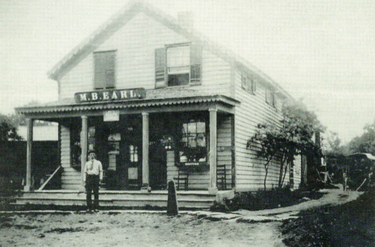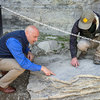Old store to become new museum
NEW SCOTLAND — A long-abandoned general store will come to life as a local history museum.
The Myron B. Earl store has stood for over 110 years, but for the last 93 it has been an empty shell on the Delaware Turnpike.
Myron Benjamin Earl had his store in the building from 1901, when it was built, until 1921. Before starting the store when he was 44, Earl was a teacher and worked at another area general store.
After Earl stopped working at 64, he moved in to the house of his only child, Mabel, and her husband, William Hilts Zeh.
After leaving the store behind, the building — which Earl was leasing from the Jocum family — became a storage facility. It still is to this day.
Somewhere between 1948 and 1952, Ed McNab acquired the land from the Jocums. “He could have bought it, or it could have been a kind of barter like people did back then,” said Clarksville Historical Society member George Miller.
When Ed McNab died, his daughter, June Alberts, inherited the property.
In 2012, the building went up for sale. Sandy Zeh, great-granddaughter of Mryon B. Earl told the historical society—of which she is a member — that she knew Alberts was thinking of selling it; the society quickly grasped the opportunity.
The society sent out a notice to its members for them to vote on whether or not to pursue acquiring the building; every member that cast a vote said “yes.”
Miller lists saving historic buildings as an integral part of the Clarksville Historical Society mission.
The Clarksville Historical Society was founded in 2004 and has grown to 112 total members as of last December. They meet every other month in the Clarksville Community Church.
In 2010, the society acquired the Woodside Schoolhouse, a site listed in the National Register of Historic Places. The schoolhouse was given to the society by the roadway authority because it was in the way of a project to straighten Route 32.
A farmer donated land for the schoolhouse on the corner of Route 32 and La Grange Lane.
“They built a foundation and plopped the building onto it,” said Susan Dee, president of the Clarksville Historical Society. The state was responsible for building the foundation.
“The original schoolhouse was moved by the state of New York,” Miller said. “I believe that, if we hadn’t stepped up, the building would have been destroyed.”
The schoolhouse is in need of some repairs before it can be used to house some of the society’s collection of artifacts and documents.
“We have them scattered in different places,” said Dee, “and would love to have them in one home.”
That one home is set to come as the Myron B. Earl store, which will need more work before being ready to act as everything the Clarksville Historical Society wants — offices, storage, and a local history museum.
“One of the questions that has been raised is, why do we need two older buildings that need a lot of rehabilitation?” Dee said.
One reason the society is interested in a new building is because in order to apply for a full charter, it needs a building that is capable of housing all of its documents and records. A full charter will allow the society to apply for grant money, while its current status as a 501c not-for-profit does not allow them to apply for grants.
“The state has money available for historical buildings every year,” Miller said. With a full charter the society could also apply for federal grants and money from private corporations. Any grant money it ends up receiving will go toward repairing both the old store and the schoolhouse.
At the Jan. 28 Zoning Board meeting, Cynthia Elliot represented the historical society and June Alberts, doing the legwork to facilitate the purchase of the store and its transformation into a museum. The board brought up issues such as parking, plumbing, and driveway maintenance.
The society hopes to have ownership of the building by May. It currently has money saved for getting the schoolhouse finished, starting this spring.




